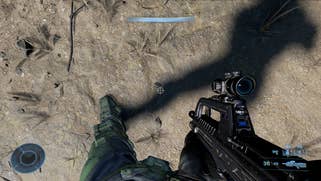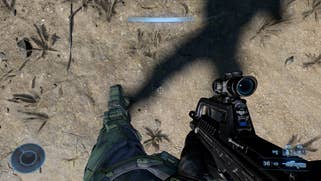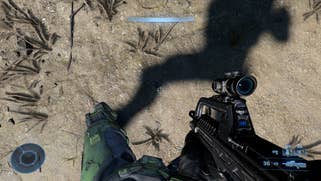Halo Infinite campaign: every console version tested
Can the base Xbox One really handle an open-world Halo?
Halo Infinite is finally available, bringing with it answers to a question we've been pondering ever since the initial 2018 SlipSpace engine reveal: can this game actually deliver a decent experience on last-gen Xbox hardware? And by extension, if it can, to what extent do you get additional scalability on the still brand-new Xbox Series consoles? The answers are intriguing - particularly when you consider Xbox Series S vs Xbox One X: a genuinely fascinating battle that pits the older, yet more powerful GPU in the Scorpio Engine against a more finely balanced machine in the form of the new junior Xbox.
The truth is, Halo Infinite serves up two distinct style of play that have very difficult implications in how the console hardware is put through its paces. The initial brace of missions - along with 'dungeon' style levels later on - is what you might call classic Halo. Interior-based in nature and more linear, albeit delivered with a profound improvement in graphical features and fidelity, these missions tend to be less of a stress test for the engine. That's juxtaposed with Halo Infinite's brand-new open world. It's here we see the SlipSpace engine pushed hard on every Xbox console. Trees, mountain ranges, enemy bases are rendered to the far distance. There's a rolling time of day, randomised cloud coverage, and even volumetric techniques to add depth to the scene. When it comes to assessing the base Xbox One, then - it's this expansive part of Halo Infinite that poses the biggest challenge.
Starting with base Xbox One, let's go straight for the jugular with performance and resolution stats. All four machines - Xbox One, One X, Series S and X - use a dynamic resolution, plus a temporal reconstruction method to boost image clarity within a frame. The vintage 2013 Xbox One and the 2016 Xbox One S refresh target 1080p at 30fps, with dynamic resolution scaling used to ensure the 30fps performance level, ranging from 720p to the target full HD. In fairness, 1080p is the norm roaming around the open world, but pitched battles will see noticeable drops to image quality. It's as good as we could realistically hope for, but the 720p lower bounds gives a limited pixel count for Xbox One to resolve fine detail on trees, or even enemies at range. In common with prior multiplayer tests, the 30fps readout is fine overall but marred by inconsistent frame-pacing giving a level of stutter and judder that makes the game look as though it's running at a lower performance level than it actually is. Performance is further blemished by hitches in fast traversal. Overall, Halo Infinite can be played on Xbox One. The graphics are fine and performance is OK on paper, but it feels rough in motion.
Xbox One X is an entirely different ball game. It has its issues but it's a dramatic improvement over the base machine and even trades punches against Xbox Series S. Just like the more advanced consoles, there's the choice of quality and performance modes. The former targets 4K at 30fps, but with DRS, resolution shifts between a range that drops to 2400x1440 at the lowest, depending on GPU load. Expect circa 1800p in open-world traversal. Similar to the base machine, its 30fps cap isn't quite as good as it should be with frame-time stutter causing problems. Still, the increase in resolution pays off, while One X's 9GB of useable memory is put to work: texture quality is boosted on Master Chief's helmet during his initial jump while skin shaders and texturing on other characters all look much improved, while shadow quality gets a bump too. Geometry LODs for terrain also use higher-grade meshes nearer to the player, reducing pop-in. We also see details, like rocks, render at range. Tree draw in the far distance is also enhanced, though it's worth stressing foliage to the near-to-mid range is identical between One and One X.
The stuttering 30fps on One X remains problematic, except there is a solution - a performance mode targeting 60fps that trades pixels for frames for a dramatically improved effect. This mode drops from a dynamic 4K in quality mode down to a dynamic 1440p. DRS is invoked heavily in big battles, giving One X a lower bounds of 1280x720 - but typically it's at numbers in-between. I've also got to say, comparing the two modes reveals only the most subtle tweaks in settings: shadow quality, and small LOD tweaks for the most part. But the boost to performance is remarkable, with only intense battles in the open world seeing Xbox One X fail to hit the target. Expect a 45fps-60fps range, depending on just how taxing the battle scenes are. Ultimately though, this is the preferred way to play on last-gen machines and is actually very, very impressive overall.
Moving on Xbox Series S, there's a twist: looking at the quality mode, Series S image quality is markedly inferior to Xbox One X. The dynamic 4K of One X drops down a locked 1080p instead, with the same 30fps target. In truth, this looks like a heavy cut-back and we'd hope to see an upgrade to 1440p at some point for Series S. Settings-wise, near-to-far foliage draw is identical between One X and Series S, as is the quality of texture filtering, depth of field, and even shadows are comparable. There are differences however, if minor: trees render slightly further towards the distance on Xbox One X, but it's a subtle change. Texture quality is very similar too, albeit a touch more blurry on Series S owing to the lower resolution. However, there are some scenarios where Series S appears to have the better of the old machine in assets but even so, Xbox One X is the sharper and cleaner of the two by running at a dynamic 4K. There are examples of actual texture quality - floor mapping at select spawn points - differing between the generations - one that may well favour Series S overall.






























Series S' performance mode? Again, generally speaking, it's operating at a lower resolution than Xbox One X, even if its dynamic resolution lower bounds is higher and overall performance is more solid. The resolution window here varies from 1706x960 to the full 1920x1080. Variable rate shading is also used here - adjusting the resolution of points of the image, in theory helping to bolster performance. The pay-off is a mostly perfect 60fps. Across all of our capture, there's barely a lurch into the 50fps region to report on. Sacrificing a more dynamic 1080p to hit and crucially to sustain 60fps seems to work out just fine.
All of which brings us to Xbox Series X: Microsoft's 12TF flagship is where we'd expect to see Halo Infinite at its very best on console and that is indeed the case, with the quality mode delivering a 60fps experience with a 2240x1440 to 3840x2160 dynamic resolution range in our tests. Everything in between is possible - though typically Series X renders at the higher end of the 4K scale. In many respects, this is basically the same as One X's quality mode in terms LOD settings, except it runs at double the frame-rate. And impressively, it's a near locked 60fps too - with only the briefest of single dropped frames during open world traversal. All this is achieved with DRS - plus variable rate shading on select elements of the screen, much like Series S.
In practise, comparing One X, Series S and Series X all together, it truly gets the best of both worlds in quality mode. Series X renders a 4K image that's less reliant on DRS than One X. You also get 60fps as standard. Not only that, Series X also uses the occasionally higher-grade textures seen on Series S. Most other settings are hard to pick apart: ambient occlusion, foliage draw and effects all fix at similar presets between the three. Even zooming up close, shadow cascades seem to trigges at the same range, while plants up ahead also draw in at the same point. Mostly, the Series X advantage is in having a dynamic 4K at 60fps - which is impressive enough.
Last for Xbox Series X is a unique 120Hz performance mode, not available to any other console at present (and sadly omitted from the Series S campaign after featuring in earlier preview builds). Rendering Halo Infinite at 120fps inevitably comes at a cost for Series X. Resolution drops heavily, residing within a 1564x960 to 2460x1440 resolution window in our samples. Still, the net result is worth taking a look at: a majority of traversal and indoor missions run at 120fps with no problem, bar minor dips beneath. That said, performance fluctuates more wildly in battle, or when the scene is generally busier in general, pushing as to a low of 80fps. Arguably the range of performance here is too jarring - especially given Xbox's VRR support at present does not seem to work in smoothing out Halo Infinite's judder.
There's one last area to tackle for Halo Infinite on Xbox. Loading times are a huge factor in playing the game, with fast travel added to quickly get around its giant map. All round, it appears Series X and S absolutely dominate last-gen consoles in getting from A to B - as you would expect with the move to solid-state storage. Let's start with the initial one-off load to the game world, after booting the app. From the main menu, Series X gets to gameplay after 12.6 seconds, Series S at 16.7, but then we have to wait a full minute for last-gen machines - 59 seconds on One X, and 61 seconds on base Xbox one. Thankfully there's not as much of a wait after booting the game and using fast travel. Selecting the Fob Golf hub, you get a good loading time advantage on newer consoles: 2.8 seconds on Series X. But then it's only an 8-9 second wait for the likes of Xbox One and One X by comparison. There's a huge current-gen advantage to booting the game, then, but afterwards all consoles load areas in at a respectable speed.
That's the full console breakdown: Halo Infinite across four Xbox platforms, and two modes. Clearly scalability is built at the heart of its engine. In effect, I'd strongly recommend Xbox One X at minimum for a great campaign experience, especially as its 60fps performance mode eliminates most stutter problems present at 30fps. Of course, Series X augments what's there with 4K60 and 120fps modes too - plus improved loading times on Series consoles. These are great features, but the core of the game is surprisingly similar across all four. In that sense, it's surprising how much base Xbox One achieves considering the age and technological limitations inherent in the platform. I hope 343 Industries addresses some issues, specifically the frame-pacing for 30fps modes, but otherwise, Halo Infinite is in a great place. The addition of co-op support would take it to a new level - as would more biomes, areas to explore in future - but whether single-player expansions are on the cards remains to be seen. For now though, the bold new direction of the Halo Infinite campaign is something to celebrate and despite its technical problems, it's still one of the very best shooters 2021.









.jpg?width=291&height=164&fit=crop&quality=80&format=jpg&auto=webp)
